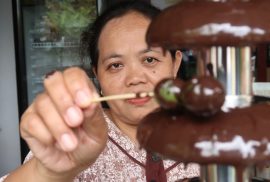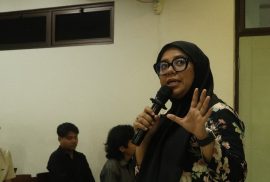 [:id]
[:id]
Kemampuan interdisiplin 5 mahasiswa UGM yaitu Hanif Nur Wahid (Teknik Pertanian, 2021), Hanif Riadi (Teknik Nuklir, 2022), Azkal Anas Ilmawan (Teknik Nuklir, 2022), Devi Fitriana (Teknik Elektro, 2022), Adinda Putri Romadhon (Teknologi Informasi, 2022), serta bimbingan Bapak Ir. Andri Prima Nugroho, Ph.D, IPU, ASEAN Eng. (Departemen Teknik Pertanian dan Biosistem UGM) berhasil menciptakan alat pengusir hama burung pipit yang efektif, terbarukan, dan keberlanjutan. Mitra yang menjadi pengguna pertama alat kami yaitu Bapak Suharno sebagai salah satu anggota Kelompok Tani Sari Makmur Sengir, Sumberharjo, Prambanan, Sleman, DIY. Bapak Suharno memiliki lahan sawah sekitar 1000 m2 dan setiap tiga bulan sekali, lahan tersebut dapat menghasilkan 600 kg padi yang seharga kurang lebih 800 ribu rupiah. Hama burung pipit menjadi ancaman utama yang menghantui petani Kelompok Tani Sengir. Jika hama burung pipit dibiarkan, massa beras yang dihasilkan akan terkuras secara perlahan. Hal tersebut merepresentasikan bahwa produktivitas padi menurun akibat hama burung pipit.

Kelompok Tani Sengir acapkali menerapkan sistem tanam serempak untuk mengatasi ancaman hama burung pipit. Selain itu, Kelompok Tani Sengir masih sering menggunakan jaring untuk mengatasi ancaman tersebut. Jaring yang digunakan disebar di atas lahan dengan tinggi sekitar 20 cm di atas permukaan tanaman padi. Burung pipit yang terjebak di jaring-jaring akan mati sehingga metode jaring tidak sesuai dengan prinsip IPM (Integrated Pest Management). Oleh karena itu, kami menciptakan alat inovatif dan efektif yang dinamakan MeMo. MeMo memiliki arti Memedi Modern. Memedi di dalam bahasa Jawa berarti sejenis makhluk yang menakut-nakuti sehingga MeMo memiliki arti yaitu alat penakut hama burung pipit yang disajikan dengan hal-hal modern. MeMo dapat beroperasi di lahan sawah dengan otomatis sehingga memberi kemudahan kepada user alias petani. MeMo memiliki material yang berasal dari limbah plastik residu. Pemilihan material tersebut terlintas ketika tim kami brainstorming, riset data, dan studi pustaka. Limbah plastik kering yang diberikan panas pada suhu tertentu, akan mencair atau dapat dikatakan fasenya berubah menjadi cair dengan viskositas tertentu. Di dalam mekanika fluida, hal yang paling utama yang membedakan antara padatan dan cairan adalah bentuk wujudnya serta sifat dari wujud tersebut. Zat dengan fase cair memiliki kemampuan untuk menyesuaikan bentuknya dengan bentuk wadahnya. Dalam aplikasi MeMo, limbah plastik kering yang sudah dipanaskan dan berubah menjadi zat cair, dapat dibentuk dengan mudah ke dalam suatu cetakan. Hal tersebut juga menjadi keunikan dari MeMo serta dapat membantu pemerintah dalam mengurangi permasalahan sampah secara perlahan.

MeMo memiliki sumber tenaga yang berasal dari panel surya dengan spesifikasi 100 WP. Panel surya yang menghasilkan suatu perubahan muatan per satuan waktu atau biasa disebut arus listrik akan digunakan untuk mengisi baterai/aki. Baterai/aki memiliki jenis arus yang searah (DC) sehingga perlu diubah arusnya menjadi arus bolak-balik (AC) dengan menggunakan komponen inverter agar dapat digunakan untuk speaker ultrasonik. MeMo juga terintegrasi dengan sensor PIR yang bekerja dengan prinsip seperti saklar. Sensor PIR berguna untuk mendeteksi objek yang berada di dekat MeMo, dalam hal ini adalah burung pipit. Sensor PIR juga digunakan untuk menghemat penggunaan energi sehingga speaker ultrasonik akan menyala jika dan hanya jika terdapat objek di depan sensor PIR.
Bapak Suharno mengatakan bahwa “MeMo memiliki desain yang elegan dan material yang tahan terhadap cuaca panas maupun hujan, MeMo juga terbukti ampuh dalam mengusir burung pipit, tetapi MeMo masih harus terus dilakukan research and development agar kedepannya MeMo dapat memiliki jangkauan pengusiran hama yang cukup luas sehingga dapat diterapkan dalam skala besar”. Dengah hadirnya MeMo diharapkan dapat membantu Kelompok Tani Sengir untuk meningkatkan produktivitas padi, mendukung energi terbarukan, dan mendukung SDGs poin ke-7 (energi bersih dan terjangkau), poin ke-9 (industri, inovasi, dan infrastruktur), poin ke-12 (konsumsi dan produksi yang bertanggung jawab), dan poin ke-15 (ekosistem daratan).
Kontributor: AN
[:en]The interdisciplinary abilities of five UGM students, Hanif Nur Wahid (Agricultural Engineering, 2021), Hanif Riadi (Nuclear Engineering, 2022), Azkal Anas Ilmawan (Nuclear Engineering, 2022), Devi Fitriana (Electrical Engineering, 2022), and Adinda Putri Romadhon (Information Technology, 2022), under the guidance of Mr. Ir. Andri Prima Nugroho, Ph.D, IPU, ASEAN Eng. (Department of Agricultural and Biosystems Engineering at UGM), have successfully created an effective, renewable, and sustainable bird scarer device. The first user of this device is Mr. Suharno, a member of the Sari Makmur Sengir Farmer Group in Sumberharjo, Prambanan, Sleman, Yogyakarta. Mr. Suharno owns a rice field of around 1000 square meters, and every three months, the field can yield 600 kg of rice, worth approximately 800,000 Indonesian Rupiah. Sparrows are a significant threat that troubles the farmers of the Sengir Farmer Group. If left unaddressed, these sparrows will gradually deplete the rice crop, leading to decreased rice productivity.

The Sengir Farmer Group often implements a synchronized planting system to combat the threat of bird sparrows. Additionally, they frequently use nets to solve this issue. The nets are spread over the fields, around 20 cm above the surface of the rice plants. Sparrows that get caught in the nets die as a result, making this net method inconsistent with the principles of Integrated Pest Management (IPM). Therefore, the team from UGM has created an innovative and effective device called MeMo, which stands for “Memedi Modern” in Indonesian, to provide a modern solution to this problem.
MeMo stands for “Memedi Modern” in the Javanese language. In Javanese, Memedi refers to a creature that frightens, so MeMo means a modern scarecrow for bird sparrows, presented with modern elements. MeMo can operate automatically in rice fields, providing convenience for farmers. MeMo is made from recycled plastic waste materials. The choice of material came up during the team’s brainstorming, data research, and literature review. Dry plastic waste, when heated to a specific temperature, will melt or change phase into a liquid with a certain viscosity. In fluid mechanics, the key difference between solids and liquids lies in their physical form and the properties of that form. Substances in a liquid phase have the ability to conform to the shape of their container. In the MeMo application, dry plastic waste that has been heated and transformed into a liquid can be easily molded into a mold. This is also a unique feature of MeMo and can assist the government in gradually addressing waste issues.

MeMo has a power source that comes from a 100 WP solar panel. This solar panel, which generates a change in charge per unit of time, commonly referred to as electric current, will be used to charge the battery. The battery operates on direct current (DC), so it’s necessary to convert the current into alternating current (AC) using an inverter to make it usable for the ultrasonic speaker. MeMo is also integrated with a PIR (Passive Infrared) sensor that works on the principle of a switch. The PIR sensor is useful for detecting objects near MeMo, in this case, the sparrows. The PIR sensor is also used to conserve energy, so the ultrasonic speaker will only turn on if and only if there is an object in front of the PIR sensor.
Mr. Suharno stated, “MeMo features an elegant design and materials that are resistant to both hot and rainy weather. MeMo has also proven effective in repelling sparrows, but ongoing research and development are essential for MeMo to have a broader range of pest deterrent capabilities, enabling large-scale applications in the future”. With the introduction of MeMo, it is hoped that it can assist the Sengir Farmers Group in enhancing rice productivity, supporting renewable energy, and contributing to several Sustainable Development Goals (SDGs). These include Goal 7 (Affordable and Clean Energy), Goal 9 (Industry, Innovation, and Infrastructure), Goal 12 (Responsible Consumption and Production), and Goal 15 (Life on Land).
[:]



